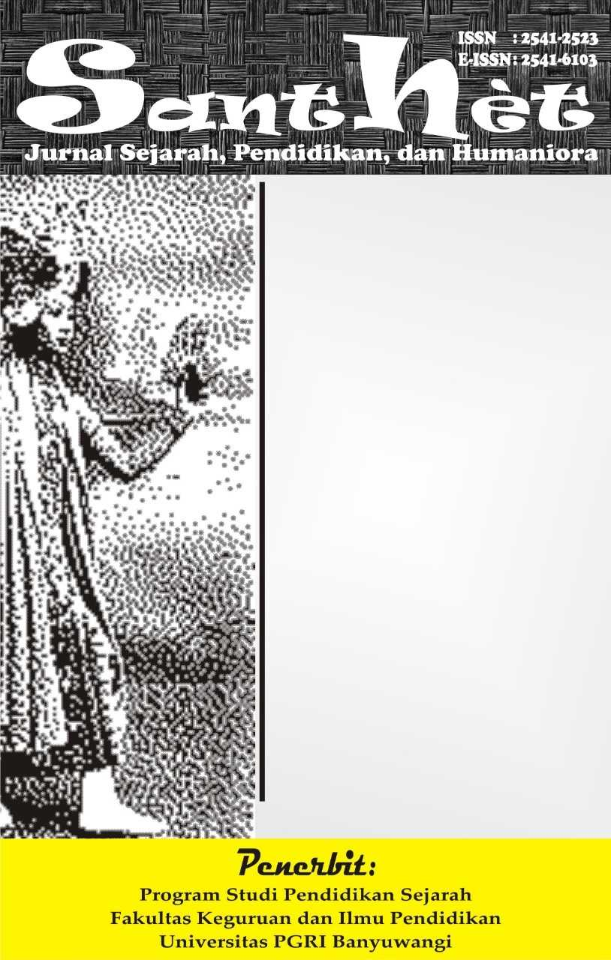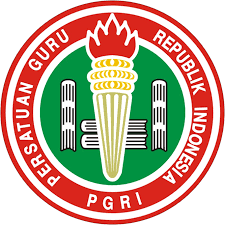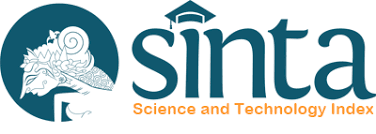GANDRUNG AS A POLITICAL COMMUNICATION TOOL IN BANYUWANGI (A Study of Antonio Gramsci's Hegemony)
GANDRUNG SEBAGAI ALAT KOMUNIKASI POLITIK DI BANYUWANGI (Suatu Kajian Hegemoni Antonio Gramsci)
DOI:
https://doi.org/10.36526/santhet.v7i2.1849Keywords:
Passion, communication, and politicsAbstract
Gandrung is one of the oldest forms of performing arts in Banyuwangi. Gandrung becomes a symbol of political communication through culture. This is clearly seen during the democratic party period. The purpose of this research is to reveal and criticize Gandrung which is used as a medium of political communication by political actors in Banyuwangi. The form of this research is descriptive qualitative. The theory used is Gramsci's hegemony. Data collection techniques using interviews, observation, and content analysis. The data analysis technique used in this study is an interactive analysis. The results of the study show that the high creativity of the people of Banyuwangi in folk art is recognized by the local government. This has become a loophole for political actors in Banyuwangi to insert political messages into Gandrung art performances. Thus, these political messages can be easily accepted by the public. This proves that if Gandrung's art is studied using Gramsi's theory, it shows that Gandrung is totally hegemony. Total hegemony is characterized by close to total mass affiliation. Society shows a strong degree of moral and intellectual unity, which is evident from the organic relationship between the government and the governed. This relationship is not colored by contradictions and antagonisms either socially or ethically.
References
Anoegrajekti, Novi, Sariono, A., Macaryus, S., & Kusumah, M. S. 2018. “Banyuwangi Ethno Carnival As Visualization Of Tradition: The Policy Of Culture And Tradition Revitalization Through Enhancement Of Innovation And Locality-Based Creative Industry.” Cogent Arts And Humanities, 5(1). Https://Doi.Org/10.1080/23311983.2018.1502913
Cangara, Hafied. 2009. Pengantar Ilmu Komunikasi Edisi Revisi. Jakarta: PT. RajaGrafindo Persada.
Cahyadi, R. 2019. “Kearifan Lokal Festival Sewu Gandrung Banyuwangi sebagai Penunjang Literasi Budaya.” Prosiding Senasbasa, 13(1). http://research-report.umm.ac.id/index.php/SENASBASA.
Cossu, A. 2021. “Clifford Geertz, Intellectual Autonomy, And Interpretive Social Science.” American Journal Of Cultural Sociology, 9(3). Https://Doi.Org/10.1057/S41290-019-00085-8
Cwalina, W., A. dan Falkowski. 2015. “Political Branding: Political Candidates Positioning Based on Inter-Object Associative Affinity Index.” Journal of Political Marketing, 14(1-2), DOI: 10.1080/15377857.2014.990842.
Dariharto. 2009. Kesenian Gandrung Banyuwangi. Banyuwangi: Dinas. Kebudayaan dan Pariwisata Kabupaten Banyuwangi.
Dianto, E. F. 2017. “Isun Hang Gandrung.” Joged, 8(2). Https://Doi.Org/10.24821/Joged.V8i2.1596.
Garzia, D. 2013. “Can Candidates Image Win Elections? A Counterfactual Assesment of Leader Effects in the Second Italian Republic.” Journal of Political Marketing, 12(4), DOI: 10.1080/15377857.2013.837303.
Gibson, N.J. 2009. “Making Art, Making Identity: Moving beyond Racialised Perceptions of Identity through Collaborative Exhibition in the New South Africa.” South African Historical Journal, 61(3). DOI: 10.1080/02582470903189790.
Harlow, R. M. 2018. “Impression Management.” The International Encyclopedia of Strategic Communication, 1(5), DOI: 10.1002/9781119010722.iesc0086.
Hendarto, Heru. 1993. Mengenal Konsep Hegemoni Gramsci: dalam Diskursus Kemasyarakatan dan Kemanusiaan. Jakarta: Gramedia.
Ispandriarno, Lukas S. 2014. “Analisis Media dan Perempuan.” Artikel Surat Kabar. 1(1). http://e-journal.uajy.ac.id/4913/
KP Desantara. 2007. Srintil 11: Penari Gandrung dan Gerak Sosial Gandrung Banyuwangi. Indonesia: Desantara.
Latifa, A. 2020. “From Gandrung Statue to the Gandrung Sewu: Approaching Two Decades of Cultural Policy in Banyuwangi (2000-2019).” Talent Development Nad Excellence, 12(2a). https://repository.unej.ac.id/bitstream/handle/123456789/96989/F.%20IB.
Littlejohn, Stephen W & Karen A. Foss. 2009. Teori Komunikasi, edisi 9. Jakarta: Salemba Humanika.
Mursidi, A. 2018. “Gandrung Seni Pertunjukan di Banyuwangi.” Jurnal Santhet, 2(1), E-ISSN: 2541-6130, P-ISSN 2541-2523, PP 10-17.
Newman, B. I. 1999a. “A Predicative Model of Voter Behavior: The Repositioning of Bill Clinton.” Handbook of Political Marketing, 259(82).
Pakarti, D., Kebayantini, N. L. N., & Krisna Aditya, I. G. N. A. 2020. “Relasi Kuasa dalam Perubahan Seni Tari Gandrung di Desa Kemiren, Kecamatan Glagah, Kabupaten Banyuwangi.” Jurnal Ilmiah Sosiologi (Sorot), 1(1).
Panjaitan, F., & Siburian, H. 2020. “Misi Kristologi Dalam Konteks Kebudayaan.” Logia, 1(1).
Https://Doi.Org/10.37731/Log.V1i1.19
Patria, A.N dan Arief. Antonio Gramsci Negara & Hegemoni. Yogyakarta: Pustaka Pelajar Budiman.
Powell, V. 2011. “A Social Identity Framework of American Hip-Hop Cultural Performance.” Social Identities: Journal for the Study of Race, Nation, and Culture, 17(4). DOI: 10.1080/ 13504630.2011.587302.
Prasetyo, M. 2018. “Omprok Gandrung Banyuwangi.” Jurnal Pendidikan Seni Rupa Undiksha, 7(2). Https://Doi.Org/10.23887/Jjpsp.V7i1.13630
Purwasito, Andrik. 2015. Komunikasi Multikultural. Yogyakarta: Pustaka Pelajar.
Raharjo, Bahagio. 2016. “Dinamika Kesenian Gandrung di Banyuwangi 1950-2013.” Jurnal Humanis, Fakultas Sastra dan Budaya Unud, 15 (2). Htpps://Doi.Org/21328-1-41366-1-10-20160620.
Shahid, M.N, Hassan, W, dan Sadar, L. 2021. “Exploring the Political Co-Brand Image & Positioning from External Stakeholder’s Perspective in Pakistan.” Journal of Political Marketing DOI: 10.1080/15377857.2021.1930328.
Srinthil. 2007. Media Perempuan Multikultural Edisi 12: Penari Gandrung dan Gerak Sosial di Banyuwangi. Depok: Desantara.
Subari, L., & Widianto, S. 2020. “Peran Ritual Meras Gandrung di Banyuwangi dalam Membentuk Kualitas Kepenarian.” Satwika : Kajian Ilmu Budaya Dan Perubahan Sosial, 4(2). Https://Doi.Org/10.22219/Satwika.V4i2.13633
Swanson & Nimmo. 1990. Komunikasi Politik: Khalayak dan Efek. Bandung: Remadja Karya W.
Tekman, HG, & Hortac¸su, N. (2002). Musik dan identitas sosial: Identifikasi gaya sebagai tanggapan terhadap gaya musik. Jurnal Psikologi Internasional, 37(5), 277285.
Wolbers, P. A. 2014. “Gandrung and Angklung from Banyuwangi: Remnants of a Past Shared with Bali.” Asian Music, 18(1). Http://www.jstor.org/stable/834159.





























